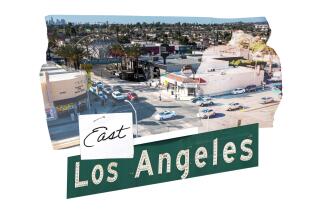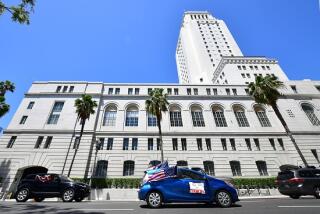Town’s Power Struggle: Is Cityhood for Fallbrook the Lesser of Two Evils?
- Share via
There are, for all intents and purposes, only two ways in and out of Fallbrook, and that might be two ways too many for some folks in this North County nook who like watching the world pass them by.
About the only use Fallbrook seems to have for a city slicker is that of a buyer of avocados, a tourist sent up the highway to buy an antique or two, or maybe a motorist who stops to pick up a bag of limes from a roadside stand.
And, to hear Larry Newcomb tell it, there’s not much love for government, either.
Newcomb, who runs an equipment rental business and seems big enough to single-handedly put a forklift on a trailer, recalls the time he complained to the county about how water was draining off the road in front of his place.
‘Spent $1,500 to Have a Study Done’
“So what did the county do? It spent $1,500 to have a study done,” he said. “Hell, why couldn’t they just open a fire hydrant and watch where the water went?”
So it stands to reason that Newcomb will vote June 7 that Fallbrook cut ties with county government and incorporate as an independent municipality.
No sirree, says Newcomb.
“Oh sure, the county has done us wrong,” he said. “But this town isn’t big enough to afford becoming a city. There’s not enough money up here.”
Maybe so, maybe not. And there are enough studies floating around to support either position, with each side ridiculing the other’s numbers, facts, assumptions and conclusions.
But both sides on the incorporation debate seem to agree on one thing: It’s important to keep Fallbrook rural--or to protect what’s left of that life style.
There is plenty of rural ambiance off the main drag, where avocado and citrus groves carpet rolling hills and screen ranch houses and opulent estates. But the town center shows a community in transition, with packing houses, agricultural supply outlets and a farm labor camp alongside mainstream commercial businesses, apartments and fast-food joints.
Some say incorporation would preserve, if not enhance, the quality of life in town by putting land-use decisions and public-works projects and services under local control. Others say they have never met a city government they liked and that the connotation, if not the reality, of incorporation is urban growth.
“I remember when this town was so small and homey,” said Carol Tobin, who has lived in Fallbrook for 18 of her 21 years. “Too many people are finding out about this place. And I don’t know if I want us to become a city and have our name in big red letters on some map.”
This isn’t the kind of place that seems to fit with big red letters on a map. The entrance sign on Mission Road says, “Welcome to Fallbrook, the friendly village.” Top billing on the sign says: “Home of Jan Eberly, 1982-83 National FFA President.”
This is the kind of place where, at the Wayside Cafe, 100 regular customers hang their own coffee mugs on the wall.
It is the kind of place no one comes to on the way to somewhere else, unless they’re just out for a ride to nowhere in particular.
The town center isn’t bordered by a freeway or a railroad; it was settled in 1869 by the Vital Reche family, which homesteaded in a grove of live oaks for the simple reason that it was pretty, was next to a stream and was available. Reche squeezed in between Mexican ranchos to the east and west and named his settlement Fall Brook.
Tract maps first appeared for the town center in 1885, and two years later a resort hotel was built, designed by Stanford White, the architect for the Hotel del Coronado. But, almost as a statement to outsiders, White’s hotel was eventually torn down, and Fallbrook became a place for growers, ranchers and cowboys working beef cattle on the rolling hills.
Indeed, Fallbrook is so removed from mainstream San Diego that, in 1893, the local folks were considering seceding from San Diego County and joining ranks with brand-new Riverside County.
“Taxes would be diminished and we would certainly receive more favors from Riverside County than we do now from San Diego,” read an article in the old Fallbrook Review.
There was even discussion at the time of setting up an entirely new county that would stretch from Oceanside to Escondido and points east, to be called Palomar County. The proposal didn’t go much further, and to this day the posture toward San Diego County government is to grin and bear it.
Should Fallbrook incorporate, it would become a sprawling city of 40 square miles, beginning near the Riverside County line to the north and ending at about the San Luis Rey River to the south, and at Camp Pendleton to the west to just over the other side of Interstate 15 on the east. The area has a population of about 26,000.
Fallbrook has considered incorporation four other times; the most recent effort, in 1981, failed by a margin of 4 to 1 because of concern that the proposed municipality would not have enough revenue to meet its expenses.
Incorporation proponents are back at it, saying the time is right this time.
But, as has been the case in similar debates throughout the county in recent years, the classic arguments for or against incorporation--ones that apply to virtually any community considering municipal government--are mostly speculative and not open to immediate answers.
- How does a community best control its growth? Does it rely on land-use decisions ultimately made by the county Board of Supervisors, of which only one member out of five is elected by Fallbrook’s voters? Or does it elect its own Town Council of five members, each accountable to the local voters and arguably more sensitive to local land-use issues?
- How does the community make sure it receives the public services--road improvements, law enforcement and all the rest--it feels it deserves and is paying for? Do Fallbrook residents continue to demand from the county government a fair return on the tax dollars they contribute, or do they incorporate and administer their own revenues, at a cost that they hope is equal to or less than the county’s?
- Can Fallbrook afford the expense of running its own government and provide the services and public works expected of a city? Or will it have to promote the very growth the community seems to despise in order to bankroll local government? Conversely, can it not afford to incorporate?
That last question, boiling down to the issue of the financial feasibility of cityhood, is the crux of the issue for many voters, both sides say. And each points to its figures, budgets, ledgers, projections and estimates to argue its point.
LAFCO Approval
The Local Agency Formation Commission, the government agency assigned by state law to bless or deny incorporation requests, says Fallbrook can afford the cost of cityhood--if the funds are “closely budgeted,” to use LAFCO’s language--based on its own staff analysis and one done by the private consulting firm of Christensen & Wallace.
But cityhood opponents say the Christensen & Wallace report, and thus the LAFCO report, is filled with faulty assumptions and bad projections. They say estimates of sales tax revenue, for instance, are overstated, reflecting “chamber-of-commerce optimism.”
To make ends meet, critics contend, the city eventually will have to cut back on the very services it is now promising to offer, will have to generate new income through business and user fees, and will be forced to promote commercial growth in order to create more sales-tax revenue.
Of the 24 candidates for five seats on the Town Council, three--Jack Wireman, Van Washburn and Lon Chaney--oppose incorporation, maintaining there is no compelling reason for becoming a city.
“If the wagon ain’t broke, don’t fix it,” Wireman says in campaigning for the status quo. And he notes that, under county rule, the Fallbrook Planning Group, an advisory panel to county supervisors, successfully down-zoned much of Fallbrook last year from one-acre minimum residential lot sizes to two-acre lots, effectively reducing the eventual population.
“That shows that, with the county system, we can actually reduce growth in this town. The county system is working,” he said.
To a point, incorporation backers say.
“From a strictly land-use issue, we should stick with the county,” agreed David Lowry, who has served on the local planning group for five years, including two as its chairman.
But Lowry is campaigning for incorporation--and for himself as a Town Council member--because the issue goes beyond zoning density decisions, he said.
“Land use is a very small part of the pie,” he said. “With land use comes the need for roads, parks, architectural control, the entire quality-of-life issue.”
To that point, Lowry and Al Fuller, a non-candidate but spokesman for the Fallbrook Incorporation Coalition, argue that Fallbrook as a city could better provide law enforcement, acquire parks, and maintain and improve roads.
Under county rule, Lowry says, Fallbrook taxpayers are subsidizing county government’s massive overhead, paying far more than the specific cost of getting a public works project completed. As a city contracting with private firms that specialize in, say, road striping, the city could get the same work done at considerable savings, he says.
“If we do nothing, the down side is that we remain a child of a county that is virtually bankrupt because of all the state-mandated programs the county is forced to fund,” Fuller said. Other crises, ranging from AIDS to jail overpopulation, are draining county funds at the expense of the daily care and feeding of unincorporated communities, he said.
How is a voter to decide whether Fallbrook should incorporate?
“The question most basically is: What’s the best way for the community to move forward?” said Lowry. “People like myself think Fallbrook is mature enough to control its own destiny.
“But it will be up to the voters to decide if they feel comfy with the candidates running for office,” he said. “If they have confidence that there are at least five people who can run this town equal to or better than the current level, with the funds that are available, they’ll vote to incorporate. If they feel uncomfortable, or are worried that we can’t do it, they’ll vote against it.”
Monday: Bonsall, a rural way station.
More to Read
Sign up for Essential California
The most important California stories and recommendations in your inbox every morning.
You may occasionally receive promotional content from the Los Angeles Times.













